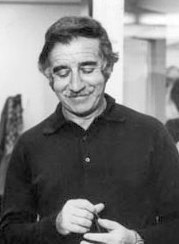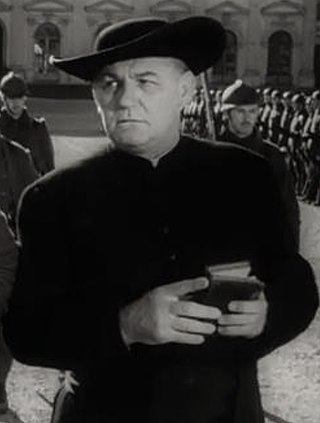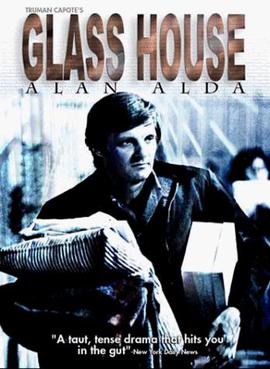Plot
One night, several prison inmates take guards prisoner to protest brutal conditions in their prison. They then make their demands known to prison warden Reynolds (Emile Meyer), a liberal-minded administrator who has complained for many years about the same conditions. James V. Dunn (Neville Brand), the prisoners' leader, meets the press outside the cell block and makes demands that they will no longer tolerate the brutal guards, substandard food, overcrowding, and barely livable conditions.
The next day inmates from two other blocks start a riot but they are forced back into the cell blocks by the state police. Negotiations between the inmates and prison officials are stymied by the state politicians who do not want to make any concessions.
Meanwhile, factions within the prisoners begin to vie for power and control within the rebellious cell block. At the same time, the state police are given the go ahead to blow a hole in the wall to end the siege. But unknown to them, the inmates inside create a human shield by tying the hostages to the interior wall.
Just in the nick of time, the governor agrees to sign a petition from the prisoners. The riot ends when the inmates see the next-day newspapers saying that they had won. But it is a pyrrhic victory for the leader, Dunn. Two weeks later he is called to the warden's office. The state legislature had overturned the governor's signature thus repudiating all the prisoners' demands.
The Warden tells Dunn that he will stand trial for leading the riot and taking hostages, charges that will mostly likely mean an additional 30-year sentence. But the Warden, who explains that he is to be replaced, tells Dunn that he did get a small victory: the mentally-ill inmates are to be moved to asylums and some prisoners will be paroled. The Warden tells Dunn that his actions were front-page news which may bring about some good. [4]
Production
The downbeat ending is indicative of the realistic social commentary prevalent throughout the film. The producer Walter Wanger had recently been in prison for shooting his wife's lover, and his experience there motivated this production. The film was shot on location at Folsom State Prison with real inmates and guards playing background roles. [5] Siegel agreed to direct the movie over eight weeks for a flat fee of $10,000. [6]
Riot in Cell Block 11 was the first film work for Sam Peckinpah. Peckinpah was hired as a third assistant casting director by Don Siegel. Reportedly, the warden was reluctant to allow the filmmakers to work at Folsom Prison until he was introduced to Peckinpah. The warden knew his influential family of judges from Fresno, California, and immediately became cooperative.
Actor Leo Gordon, who plays hardened convict Carney, had served five years in San Quentin State Prison for armed robbery. Because of this, the warden at Folsom originally objected to Gordon appearing in the film, but Siegel convinced him that Gordon was no threat to the prison. [7]
Siegel's location work and his use of actual prisoners as extras made a lasting impression on Peckinpah's later career. He would work as an assistant to Siegel on four additional films including Private Hell 36 (1954), An Annapolis Story (1955), Invasion of the Body Snatchers (1956) and Crime in the Streets (1956). [8]

Donald Siegel was an American film and television director and producer.

Folsom State Prison (FSP) is a California State Prison in Folsom, California, U.S., approximately 20 miles (32 km) northeast of the state capital of Sacramento. It is one of 34 adult institutions operated by the California Department of Corrections and Rehabilitation.

San Quentin State Prison (SQ) is a California Department of Corrections and Rehabilitation state prison for men, located north of San Francisco in the unincorporated place of San Quentin in Marin County.

The New Mexico State Penitentiary riot, which took place on February 2 and 3, 1980, at the Penitentiary of New Mexico (PNM) south of Santa Fe, was the most violent prison riot in U.S. history. Inmates took complete control of the prison and twelve officers were taken hostage. Several inmates were killed by other prisoners, with some being tortured and mutilated because they had previously acted as informants for prison authorities. Police regained control of PNM 36 hours after the riots had begun. By then, thirty-three inmates had died and more than two hundred were treated for injuries. None of the twelve officers taken hostage were killed, but seven suffered serious injuries caused by beatings and rapes.

Escape from Alcatraz is a 1979 American prison action thriller film directed and co-produced by Don Siegel, written by Richard Tuggle, and starring Clint Eastwood alongside Patrick McGoohan, Fred Ward, Jack Thibeau, and Larry Hankin with Danny Glover appearing in his film debut.

Inside the Walls of Folsom Prison is a 1951 American film noir crime film directed by Crane Wilbur and starring Steve Cochran and David Brian. Set in Folsom State Prison in California, the film was seen both in the United States and Europe.

Oregon State Penitentiary (OSP), also known as Oregon State Prison, is a maximum security prison in the northwest United States in Salem, Oregon. Originally opened in Portland 172 years ago in 1851, it relocated to Salem fifteen years later. The 2,242-capacity prison is the oldest in the state; the all-male facility is operated by the Oregon Department of Corrections (ODOC). OSP contains an intensive management wing, which is being transformed into a psychiatric facility for mentally ill prisoners throughout Oregon.

Emile Meyer was an American actor, usually known for tough, aggressive, authoritative characters in Hollywood films from the 1950s era, mostly in Westerns or thrillers.

James Aloysius Johnston was an American politician and prison warden who served as the first and longest-serving warden of Alcatraz Federal Penitentiary, serving from 1934 to 1948. He had earlier served as wardens of California state prisons at Folsom (1912-1913) and San Quentin (1914-1924).

The Ohio Penitentiary, also known as the Ohio State Penitentiary, was a prison operated from 1834 to 1984 in downtown Columbus, Ohio, in what is now known as the Arena District. The state had built a small prison in Columbus in 1813, but as the state's population grew the earlier facility was not able to handle the number of prisoners sent to it by the courts. When the penitentiary first opened in 1834, not all of the buildings were completed. The prison housed 5,235 prisoners at its peak in 1955. Prison conditions were described as "primitive" and the facility was eventually replaced by the Southern Ohio Correctional Facility, a maximum security facility in Lucasville. During its operation, it housed several well-known inmates, including General John H. Morgan, who famously escaped the prison during the Civil War, "Bugs" Moran, O. Henry, Chester Himes, and Sam Sheppard, whose story is said to have inspired the movie The Fugitive. A separate women's prison was built within its walls in 1837. The buildings were demolished in 1997.

Michigan State Prison or Jackson State Prison, which opened in 1839, was the first prison in Michigan. After 150 years, the prison was divided, starting in 1988, into four distinct prisons, still in Jackson: the Parnall Correctional Facility which is a minimum-security prison; the G. Robert Cotton Correctional Facility where prisoners can finish their general education; the Charles Egeler Reception and Guidance Center which is the common point of processing for all male state prisoners sentenced to any Michigan prison; and the Cooper Street Correctional Facility which is the common point for processing of all male state prisoners about to discharge, parole, or enter a community center or the camp program.

California State Prison, Sacramento (SAC) is a male-only state prison located in the city of Folsom, in Sacramento County, California. The facility is also referenced as Sacramento State Prison, CSP-Sacramento, CSP-SAC, and occasionally, New Folsom or New Folsom Prison which was its official name prior to October 1992.
"Riot in Cell Block #9" is a R&B song composed by Jerry Leiber and Mike Stoller in 1954. The song was first recorded by The Robins the same year. That recording was one of the first R&B hits to use sound effects and employed a Muddy Waters stop-time riff as the instrumental backing.
Harley Oliver Teets was the warden of San Quentin State Prison from 1951 until his death in 1957. During that time he presided over executions performed in San Quentin's notorious gas chamber. Teets is probably best known for seizing the manuscript of one of condemned prisoner Caryl Chessman's books, arguing that since it was written on death row, it constituted "prison labor".
The San Quentin Six were six inmates at San Quentin State Prison in the U.S. state of California who were charged with actions related to an August 21, 1971 escape attempt that resulted in six deaths and at least two persons seriously wounded. They were Fleeta Drumgo, David Johnson, Hugo Pinell, Johnny Larry Spain, Willie Tate, and Luis Talamantez. The dead included George Jackson, a co-founder of the Black Guerrilla Family; two other inmates, and three guards.

The Marquette Branch Prison (MBP) is located in Marquette, Michigan on the south shore of Lake Superior. The prison, which opened in 1889, is a facility of the Michigan Department of Corrections that holds about 1,100 inmates in maximum and minimum-security housing. The inmate population consists of adult males, aged eighteen and older. The prison was listed on the National Register of Historic Places as State House of Correction and Branch Prison on November 23, 1977.

The Montana State Prison is a men's correctional facility of the Montana Department of Corrections in unincorporated Powell County, Montana, about 3.5 miles (5.6 km) west of Deer Lodge. The current facility was constructed between 1974 and 1979 in response to the continued degeneration of the original facility located in downtown Deer Lodge.

Women's Prison is a 1955 American film noir crime film directed by Lewis Seiler and starring Ida Lupino, Jan Sterling, Cleo Moore, Audrey Totter, Phyllis Thaxter and Howard Duff.

United States Penitentiary, Alcatraz Island, also known simply as Alcatraz or The Rock, was a maximum security federal prison on Alcatraz Island, 1.25 miles (2.01 km) off the coast of San Francisco, California, United States. The site of a fort since the 1850s, the main prison building was built in 1910–12 as a U.S. Army military prison.

Truman Capote's The Glass House is a 1972 American made-for-television drama film starring Alan Alda, Vic Morrow, and Clu Gulager, directed by Tom Gries. It originally aired on CBS on February 4, 1972.

















